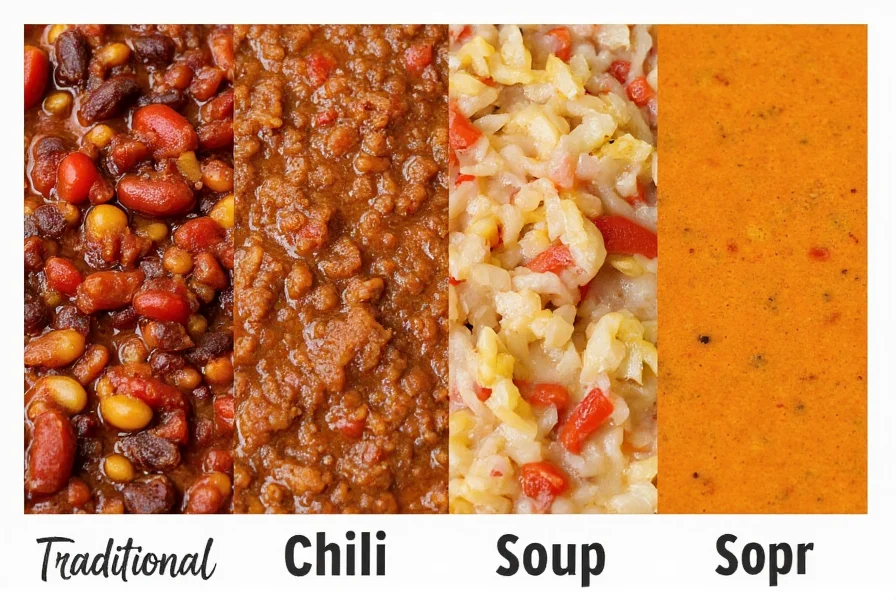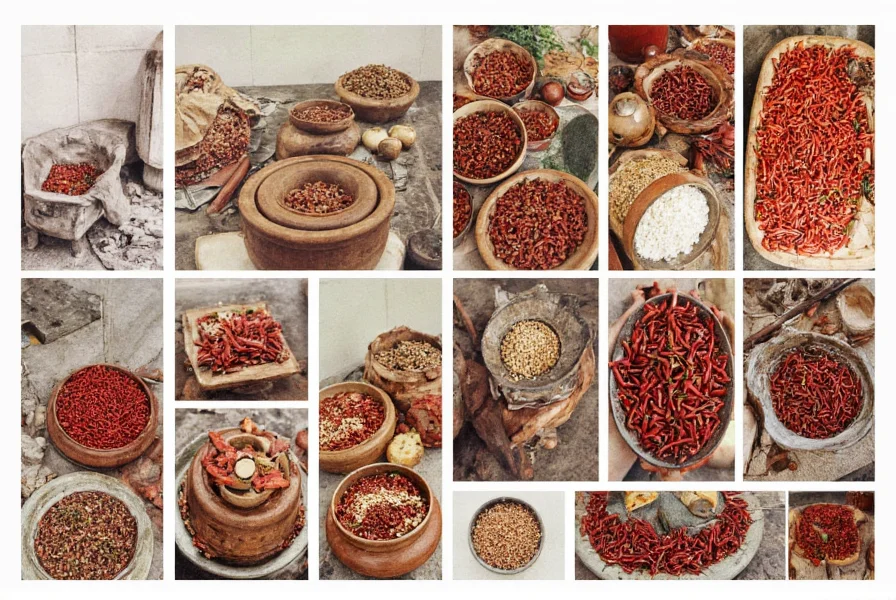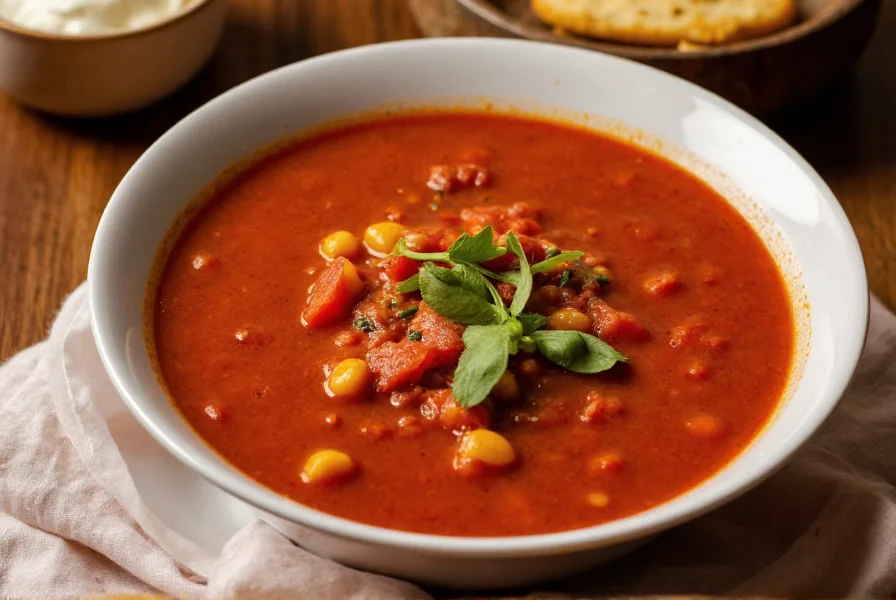When examining is chili a soup from a culinary perspective, the distinction becomes clear. Soups typically feature broth or stock as their primary liquid component, while chili relies on a tomato-based sauce or minimal liquid that reduces during cooking. This fundamental difference in preparation and texture places chili firmly in the stew category according to most culinary authorities.
Understanding Soup vs. Stew vs. Chili
The confusion around is chili considered soup often stems from overlapping characteristics between liquid-based dishes. Let's examine the key distinctions:
| Dish Type | Liquid Content | Texture | Primary Ingredients | Serving Temperature |
|---|---|---|---|---|
| Soup | High (broth/stock based) | Thin, pourable | Meat, vegetables, broth | Hot |
| Stew | Moderate (thickened) | Thick, chunky | Meat, vegetables, minimal liquid | Hot |
| Chili | Low (reduced sauce) | Very thick, hearty | Meat, chili peppers, spices, optional beans | Hot |
Culinary Definitions and Historical Context
The question is chili soup or stew requires understanding both food science and culinary tradition. According to the Food Lover's Companion, a stew is defined as "a dish of solid food simmered in liquid, served in the resultant gravy." Chili fits this description perfectly, with its meat and vegetables simmered in a spicy tomato-based sauce.
Historically, chili originated in the American Southwest as a practical meal for cowboys and settlers. The original Texas-style chili contained only meat and chili peppers—no beans or tomatoes—making it even less soup-like. This version, known as "chili con carne" (chili with meat), was designed to be a complete, hearty meal that could sustain workers through long days.

Expert Opinions on Chili Classification
Professional chefs and culinary institutions consistently classify chili as a stew rather than a soup. The Culinary Institute of America states: "Chili is a specific type of meat stew characterized by its use of chili peppers and other spices."
When addressing the common question why isn't chili considered a soup, food scientists point to several key factors:
- Consistency: Chili has a much thicker texture than soup, often requiring a spoon rather than a bowl with sides
- Liquid ratio: Soups typically contain 60-80% liquid, while chili contains 30-40% liquid after cooking
- Preparation method: Chili ingredients are browned first, then simmered with minimal liquid that reduces significantly
- Serving style: Chili is almost always served as a main course, while soup frequently serves as an appetizer
Regional Variations and Common Misconceptions
The debate around is chili a soup debate often intensifies due to regional differences in preparation. Some Midwestern and Eastern versions of chili include more liquid and are sometimes served over spaghetti ("chili spaghetti"), which might appear more soup-like.
However, these variations don't change the fundamental classification. Even the thinner versions of chili maintain the characteristic spice profile and ingredient composition that distinguish it from traditional soups. The International Chili Society, which oversees competitive chili cooking, explicitly categorizes chili as a "stew" in all its competition guidelines.

Practical Implications of the Classification
Understanding is chili soup for cooking purposes matters for home chefs. The stew classification affects:
- Cooking technique: Chili requires longer simmering to develop flavors and thicken properly
- Ingredient balance: Proper chili needs less liquid than soup recipes
- Serving suggestions: Chili pairs better with toppings like cheese and sour cream than traditional soups
- Storage considerations: Chili's thicker consistency affects how it freezes and reheats
When following recipes, recognizing that chili is a stew helps avoid common mistakes like adding too much liquid, which would create a soup-like consistency that most chili enthusiasts would reject.
Conclusion: The Nuanced Answer to Is Chili a Soup
While the question is chili a soup yes or no might seem straightforward, the culinary reality contains some nuance. Technically, chili is classified as a stew, not a soup, based on its preparation method, ingredient ratios, and final texture. However, certain regional variations with higher liquid content might blur these lines.
The most accurate statement is that chili represents a specific category of stew with distinctive characteristics. Calling it a soup would be inaccurate according to culinary standards, though the confusion is understandable given the liquid component in the dish.
Is chili considered a soup in culinary terms?
No, chili is not considered a soup in culinary terms. It's classified as a stew due to its thicker consistency, minimal liquid content, and preparation method. While both are liquid-based dishes, soups typically have broth as their primary component, whereas chili features a reduced tomato-based sauce with hearty ingredients that characterize stews.
What makes chili different from soup?
Chili differs from soup primarily in its consistency and preparation. Soups contain 60-80% liquid and are often served as appetizers, while chili has only 30-40% liquid after cooking, features browned meat first, and is served as a main course. The thick, hearty texture of properly made chili aligns with stew characteristics rather than soup.
Can chili ever be classified as a soup?
While traditional chili is classified as a stew, some regional variations with higher liquid content might approach soup-like consistency. However, these versions still maintain the characteristic spice profile and ingredient composition of chili. Culinary authorities consistently classify even thinner chili versions as a type of stew rather than soup due to preparation methods and cultural context.
Why do people confuse chili with soup?
People confuse chili with soup because both are warm, liquid-based dishes served in bowls. The confusion is compounded by certain regional chili variations that contain more liquid, and by the fact that some restaurants serve thinner chili that resembles soup. Additionally, the broader category of 'soups and stews' often groups these dishes together in casual conversation.
How should I adjust my cooking if I want chili to be less soup-like?
To achieve proper chili consistency, simmer the dish uncovered to allow liquid reduction, use minimal added liquid (broth or water), and include ingredients that naturally thicken the mixture like tomatoes and beans. Most authentic chili recipes call for the liquid to reduce significantly during cooking, resulting in a thick, hearty texture that coats the back of a spoon rather than pouring freely like soup.











 浙公网安备
33010002000092号
浙公网安备
33010002000092号 浙B2-20120091-4
浙B2-20120091-4